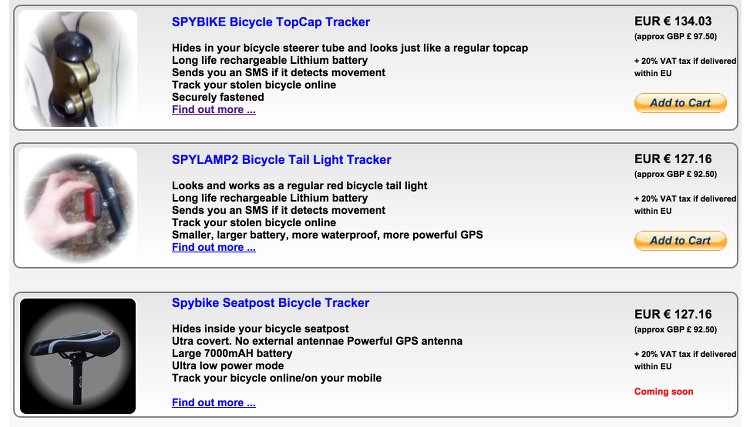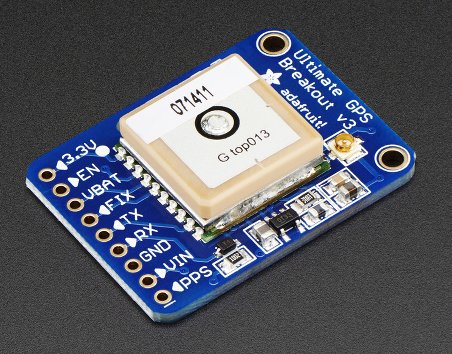- Home
- My Assignments
- Project Management - Complete
- Computer Aided Design - Complete
- Computer Controlled Cutting - Complete
- Electronics Production - Complete
- 3D Scanning and Printing - Complete
- Electronics Design - Complete
- Embedded Programming - Complete
- Computer-controlled Machining - Complete
- Molding and Casting - Complete
- Input Devices - Complete
- Output Devices - Complete
- Composites - Complete
- Networking and Communications - Complete
- Interface and Application Programming - Complete
- Applications and Implications - Complete
- Mechanical and Machine Design - Complete
- Invention, Intellectual Property, and Income - Complete
- Final Project
Who has done what before hand?
In My initial proposal (which was far more ambitious!) I looked at existing examples of bike hardware and made a comparison table. This helped me see what features are available already regarding bike hardware that helps find bikes. For this project however, I will whittle down that list and make the information more relevant.
Spybike
Spybike make products very similar to what I wish to make. They offer three types of discrete tracking device. The three types are listed below:

These are "armed" by bringing an RFID tag in close range of the device. It begins tracking when the motion sensor detects a certain amount of movement. The user then receives an SMS message with a link to the spybike website which contains all of the bikes movements from the moment it was triggered.
This device provides an excellent solution to the problem of bike theft. As you can see, however, there is a rather hefty price tag for the devices. This is something which I believe is avoidable by making my own solution in the lab.
Sobi
This is a social biking platform similar to that of London's "Boris Bike" Scheme. It can be provided for cities or campuses. The user registers online then can reserve and ride the bikes provided. The hardware on the bikes enable the user to track their activity through a phone app. This includes things like distance traveled, and CO2 emissions saved as a result. It is a great example of how phones can be linked to social biking. The product does solve the issue of bike theft but not in a way that is easy to implement for an individual. Spy bike is much better at that. But the hardware aspect of this is most interesting.
Bitlock
This product is a smart bike lock, which is unlocked when the user comes in close range. It can also be manually locked and unlocked as needed. It solves the issue of bike theft in the same way any bike lock does but it also enables a form of bike sharing. A friend with the app can be given permission by the owner of the bike to unlock it and use it. Furthermore, the lock can tell the user where the bike is through the app and tracks the user's activity. There is excellent use of technology in this product but would not necesarily solve the issue of recovering a stolen bike. As with any bike lock, if the theive really wants to break it, they will.
Bike Spike
Bike spike is a tracking device very similar to Spybike, but a bit more advanced. The device fits to where a water bottle cage would normally go. It is able to track the users activity and track the bike when it is stolen. The tracking feature can be triggered in two ways. One is though motion detection and the other is by setting a geo-fence. There is also tamper detection and crash detection. One downside of the product is that it requires a montly subscription. I do not intend to have such running costs for my prototype. The worst way the user would be required to top up a SIM card if i include one like Spybike does. Again, the initial cost of buying this product is $129 which is admittedly cheaper than spybike but then the monthly subscription costs start at $5 a month.
Helios
A manufacturer of smart handle bars, they produce different types of handle bar with the same smart technology. Their handlebars come with a lighting system that can be controlled by one's iPhone via Bluetooth. It provides illumination, indicators and a speedometer which changes the colour of some of the lights according to the speed of the user. This is great as it shows how crucial bike parts can be made "smart". It also includes GPS tracking to track the user's activity. At $279 however it is a rather expensive accessory for the vast majority of bikes.
A quick summary:
It is clear what I am aiming to do has many examples of it beig carried out, the above being a few of the most popular and relevant. But I believe that making a cheaper item that can be fitted to the majority of bikes will make a great addition to this area. Another advantage to this project shines here. That there is a lot of existing work to look at, alter and hopefully improve upon.
The device will text the user with the position of the bike when told to do so by the user:-
Given the time avaliable and the requirements of the academy, I think it will be challenging enough to get the device to send a reading from a GPS module to the user's phone via SMS. It therefore also doesn't require any external server that some of most of the existing examples use.
The device will be battery powered:-
I don't wish to make a minimum amount that my device must be able to run for at this stage. So long as it can operate with a batter, that will be sufficient.
The device will ba able to fit inside a bicycle handle bar:-
After looking at these products, I believe it that the most convenient place for my project to be housed is inside a bicycle handle bar. Like with the spybike products, I beleive it is possible to make the hardware narrow enough to do so.
